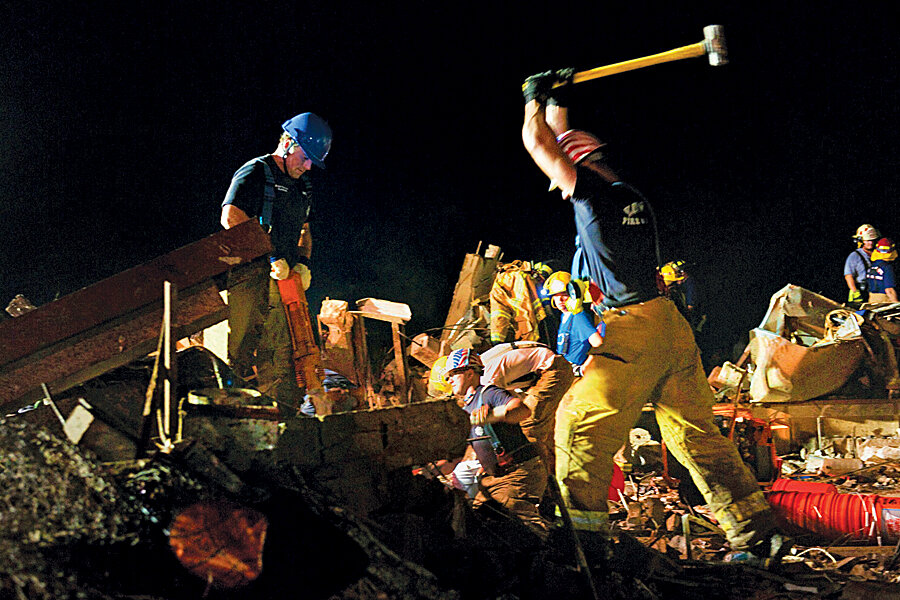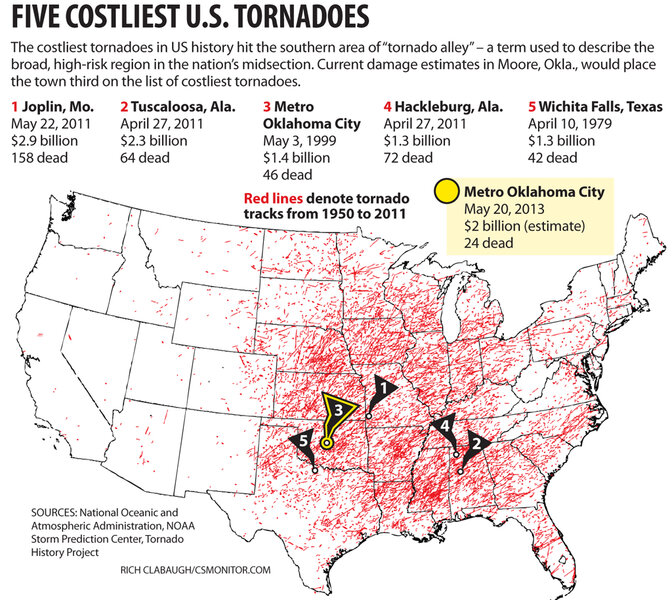When disaster strikes America, a more skilled response
Loading...
| Moore, Okla.
On the afternoon of Monday, May 20, the destruction in Moore, Okla., seemed beyond comprehension. More than 13,000 homes were damaged by a tornado that, by meteorological standards, was a raging monster. Residents emerged from the shipwrecks of what had once been houses, not knowing who among their neighbors had fled, who might be hunkered down under the rubble, and who might be dead.
The search and rescue, it seemed, could take days. Instead, despite hard rains and darkness, the initial sweep was done overnight.
Oklahoma's preparation and its prompt response to one of the most destructive tornadoes in history are examples "other communities would be well to emulate," says David McEntire, an emergency planning professor at the University of North Texas in Denton.
In part, it was a product of Oklahoma itself – a parable of how repeated exposure to weather's most ferocious extremes builds preparedness into the very DNA of "tornado alley." More broadly, it is also evidence that the United States, as a nation, is simply getting better at dealing with natural disasters.
Improved forecasts are helping to limit the loss of life, and the fallout from hurricane Katrina has dramatically reshaped disaster response. Federal, state, and private officials, who once had only a vague notion of what their counterparts were doing, now coordinate to the point that folks on the ground know who will be collecting lost pets and who will be flipping burgers for the droves of emergency workers.
To be sure, the Moore tornado was not of the scale of Katrina or superstorm Sandy. But the story of how ATV-riding urban search-and-rescue teams here were on their second and third rounds of searches less than 24 hours after the tornado touched down suggests how much has changed since New Orleans was lawless and underwater for days in late summer of 2005.
"The higher profile of these types of disasters, and the nature of their physical and social impact, brings this closer to home than ever before," says Liesel Ritchie, director of research at the National Hazards Research and Applications Information Center at the University of Colorado in Boulder. "It's not like we haven't experienced tornadoes before, but it's on the radar in ways that we haven't had prior."
For Oklahoma, experience has honed competence. "Sadly, this is not our first rodeo," says emergency volunteer Amand McCoy.
Oklahoma's two urban search-and-rescue units were lined up to respond to destroyed buildings and trapped citizens, and thanks to a mutual aid agreement between states, the unit from Texas was also sent. Dozens of smaller search units, too, descended quickly, helped by local firefighters called in by mutual aid. Oklahoma City sent crews and equipment, as well, arriving almost immediately on site. Even a tableful of young professionals, updating social media websites and triaging reporters' requests, was called in when Moore's public affairs officer tapped a local advertising firm.
It was essentially a small army mobilized at a moment's notice and almost seamlessly synchronized. At one staging area, the fire crew from Morgans Corner learned from an organizational chart that its job was to sling more than 1,000 burgers a day to hungry police officers and firefighters at the official barbecue pit. At the Home Depot, Debbie Cunningham oversees Official Support Function-11 – which, put in simpler terms, is a lost and found for pets.
None of this comes without extensive coordination and training.
"There's a lot of planning that goes into preparedness and being ready to respond.... For Oklahoma, this is the No. 1 hazard and there are set functions that have to be performed.... You have to know who's going to do them, and you have to drill them. And the result is that the state is very much on top when something happens," says Professor McEntire. "They don't really need to go look at the plan to figure out what to do. It's a well-oiled machine."
Albert Ashwood, Oklahoma's emergency management director, puts it in folksier terms: "We have a saying in Oklahoma: 'You don't hand out business cards at disaster scenes' – meaning that everybody not only knows each other but has worked with each other in the past. Everybody knows what role they play."
Those were not sentiments associated with federal disaster coordination in the aftermath of hurricane Katrina. But the Federal Emergency Management Agency (FEMA) is an integral part of the Moore relief effort. Three of its search-and-rescue teams were on the ground the morning after, and the agency had sent a liaison to the state's emergency-response center the day before the tornadoes hit.
For Mike Ebert, vice president for communications with the Southern Baptist Convention in Atlanta, that speaks to fundamental changes within FEMA. In the past, he felt that federal officials had little interest in how to marshal his group's capabilities, which range from bringing in roof tarps to providing child care. But with the arrival of current FEMA Administrator Craig Fugate in 2009, that began to change.
"We noticed right away an increase in communication and a real desire on FEMA's side to say, 'Hey, we have all these resources here from Southern Baptist, let's take advantage of it and let them know we're really counting on them,' " Mr. Ebert says.
One notable change is that FEMA has invited his organization and others to send a representative to Washington to participate in twice-a-day briefings about the logistics of what is needed and where.
"The federal government realizes that the private organizations that are actively seeking to serve those affected by disaster have a role, and it's important that we work together," says Ron Busroe, development secretary for the Salvation Army, which also has a seat at the FEMA briefings. "We have different roles ... but we work in collaboration. It's a good thing."
This refined ability to respond quickly to dis-aster – positioning resources where they might be most needed – has increasingly been shaped by the ability to forecast with certainty where extreme weather will strike.
Take the Columbus Day storm of 1962. It was the strongest nontropical cyclone to hit the US during the past 100 years, battering a stretch of Pacific coastline from northern California to British Columbia with winds gusting to 150 miles per hour.
"If you look at The Seattle Times the day before, they were talking about 'partly cloudy' or something," says Cliff Mass, professor of meteorology at the University of Washington in Seattle.
Thanks to better computer modeling and weather satellites, meteorologists began to get nearly all the big storms right in the 1990s – first, with forecasts a few days ahead of time, then, in the case of Sandy, four to six days ahead of time, notes Dr. Mass.
Part of the success with preparing for Sandy stemmed from forecasters' use of a powerful computer model in Europe. Now, National Weather Service computers are being upgraded with money from Sandy relief. Meteorologists hope to be able to make more accurate forecasts as far as 16 days in advance. Of special interest, Mass says, are forecasts in the seven- to 14-day range. That could help forecasters forewarn Western dam operators when currents of warm, moist air flow in from the Pacific, bringing heavy rains. With more time to lower water levels in their reservoirs, the dam operators could improve flood control, he says.
Improvements in longer-term forecasting mirror improvements in the minute-by-minute forecasts crucial to tornado warnings. In the mid-1960s, the average warning time for a tornado was three minutes after it touched down. On May 20, the National Weather Service issued a warning covering Moore 16 minutes before touchdown, and it took the tornado another 20 minutes to arrive, essentially giving residents 36 minutes' warning.
For Moore residents, that was an eternity. Most people in the tract-house neighborhood off Telephone Road, near the epicenter of destruction, simply left. Some drove out of the strike zone; others went to fast-food restaurants, whose walk-in coolers are nearly bombproof and bolted to the ground.
"Seventeen minutes is plenty of time to get a long way from the path of a tornado," says Thomas Grazulis, a tornado historian in St. Johnsbury, Vt.
"Yeah, people just leave. That's what I do," says Todd Smith, whose home was barely grazed by the May 20 tornado. "You watch the track, you listen to the warnings, and you make the call and go. That's why everybody buys tornado insurance, so you can go back, pick up the pieces, and rebuild."
How they rebuild, however, remains a weak point in America's disaster preparedness, some say. Many communities strengthen building codes after natural disasters, much like Florida did in 2002 after a series of hurricanes hit in the 1990s. That process is also now taking place in the area wrecked by Sandy last October.
But, at the same time, there is a desire to rebuild as quickly as possible. Some individuals either don't have the money to meet new standards or don't want to spend it. And some officials say safety is up to each individual, not something to be imposed.
Moore's mayor has said he will push to make storm shelters mandatory in home construction. But when Moore was hit by an even stronger tornado in 1999, that decision was left in the hands of homeowners.
There's an ad hoc quality to how various communities respond. After a giant tornado hit Parkersburg, Iowa, in 2008, many residents added storm shelters. But the town of about 1,900 people did not change its building code to require them. As a result, the high school, rebuilt after the storm, has a shelter with thick concrete walls and a reinforced concrete ceiling. But the elementary school, which was not damaged, does not have a similar shelter.
After Florida was hit by severe hurricanes, engineers designed better ways to keep roofs attached to buildings.
"Hopefully Moore and other cities will look at the best way to rebuild for property and building protection," says Nancy Kete, managing director of the Rockefeller Foundation, noting that it's equally as vital for communities to focus on protecting people.
• Staff writers Mark Guarino, Pete Spotts, and Ron Scherer contributed to this report.








